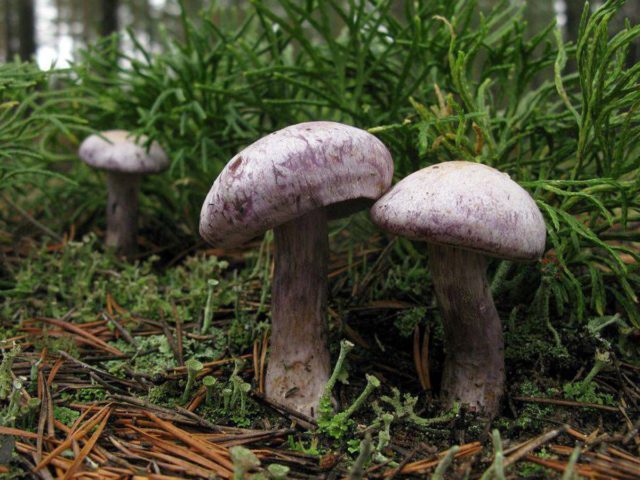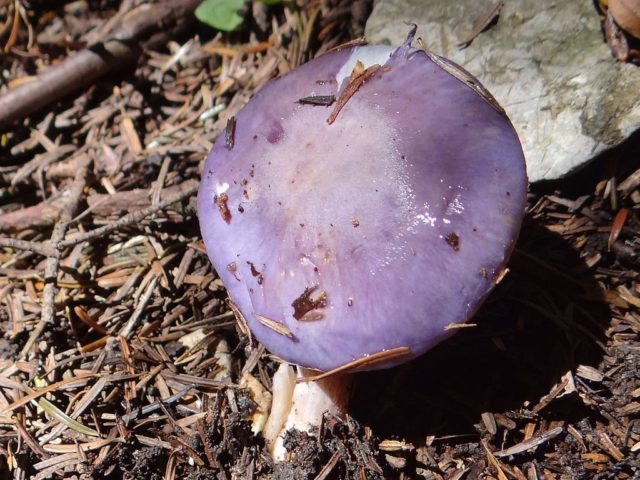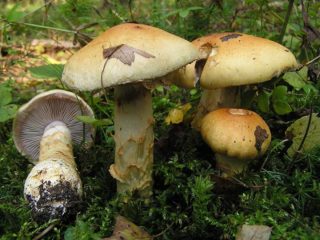Content
Camphor cobweb mushroom (Cortinarius camphoratus) is a lamellar mushroom from the Cobweb family and the Cobweb genus. It was first described in 1774 by Jacob Schaeffer, a German botanist, and named amethyst champignon. Its other names:
- pale purple champignon, from 1783, A. Batsch;
- camphor champignon, since 1821;
- goat's web, since 1874;
- Amethyst cobweb, L. Kele.
What does the camphor web look like?
A special feature of this type of fruiting body is its smooth cap, as if cut out on a compass. The mushroom grows to medium-large size.

Group in a pine forest
Description of the cap
The cap is spherical or umbrella-shaped.In young specimens it is more rounded, with folded edges pulled together by a veil. In adulthood, it straightens out, becoming almost straight, with a gentle elevation in the center. The surface is dry, velvety, covered with longitudinal soft fibers. Diameter from 2.5-4 to 8-12 cm.
The color is uneven, with spots and longitudinal stripes, noticeably changing with age. The center is darker, the edges are lighter. Young camphor spiderwort has a soft amethyst, light purple color with pale grayish veins. As it matures, it changes to lavender, almost white, retaining a darker, brownish-purple spot in the middle of the cap.
The pulp is dense, fleshy, colored with alternating white and lilac layers or pale lilac. In overaged ones it has a reddish-ocher tint. The plates of the hymenophore are frequent, variegated in size, dentate-accreted, and in the early stages of growth covered with a cobwebby white-gray blanket. Young specimens have a soft lilac color, which changes to brown-sand or ocher. Spore powder is brown.

Along the edges of the cap and on the stem, reddish-ocher web-like remains of the bedspread are visible.
Description of the leg
Camphor cobweb has a dense, fleshy cylindrical leg, slightly expanding towards the root, straight or slightly curved. The surface is smooth, velvety-felt, there are longitudinal scales. The color is uneven, lighter than the cap, white-violet or lilac. Covered with a white downy coating. The length of the leg is from 3-6 cm to 8-15 cm, the diameter is from 1 to 3 cm.
Where and how does it grow
Camphor cobweb is distributed throughout the Northern Hemisphere.Habitat: Europe (British Isles, France, Italy, Germany, Switzerland, Sweden, Poland, Belgium) and North America. It is also found in Russia, in the northern taiga regions, in Tatarstan, Tver and Tomsk regions, in the Urals and Karelia.
Camphor cobweb grows in spruce forests and next to fir, in coniferous and mixed forests. Usually a colony is represented by a small group of 3-6 specimens freely scattered throughout the territory. Occasionally more numerous formations can be seen. The mycelium bears fruit from late August to October, remaining in one place for several years.
Is the mushroom edible or not?
Camphor cobweb is an inedible species. Toxic.
Doubles and their differences
Camphor webwort can be confused with other species of Cortinarius, which are purple in color.
White-violet cobweb. Conditionally edible mushroom of low quality. The pulp has an unpleasant musty odor. Its color is lighter, and it is smaller in size than camphor.

A characteristic feature is the club-shaped leg
Goat's web or goat's web. Poisonous. It has a pronounced tuberous stalk.

This species is also called stinky because of its indescribable aroma.
Silver web spider. Inedible. It is distinguished by a light-colored, almost white, with a bluish tint, cap.

Lives in deciduous and mixed forests from August to October
Gossamer blue. Inedible. Differs in a bluer shade of color.

This species prefers to settle next to birch trees
Conclusion
Camphor cobweb is a toxic agaric fungus with an unpleasant-smelling pulp.It lives everywhere in the Northern Hemisphere, in coniferous and mixed forests, forming mycorrhizae with spruce and fir. Grows from September to October. It has inedible counterparts from among the blue cobwebs. It cannot be eaten.









